#stfidelisofsigmaringen
Text
Nostra Signora di Bonaria / Our Lady of Bonaria, Island of Sardinia (1370), Nuestra Señora de Luján / Our Lady of Luján in Buenos Aires, St Fidelis of Sigmaringen Martyr and Memorials of the Saints - 23 April 2023
Nostra Signora di Bonaria / Our Lady of Bonaria, Island of Sardinia (1370) – 24 April: In 1908, Pope Pius X, declared Our Lady of Bonaria the Patron of Sardinia.HERE:https://anastpaul.com/2021/04/24/our-lady-of-bonaria-island-of-sardinia-1370-our-lady-of-lujan-in-buenos-aires-and-memorials-of-the-saints-24-april/
Nuestra Señora de Luján / Our Lady of Luján in Buenos Aires – 24…
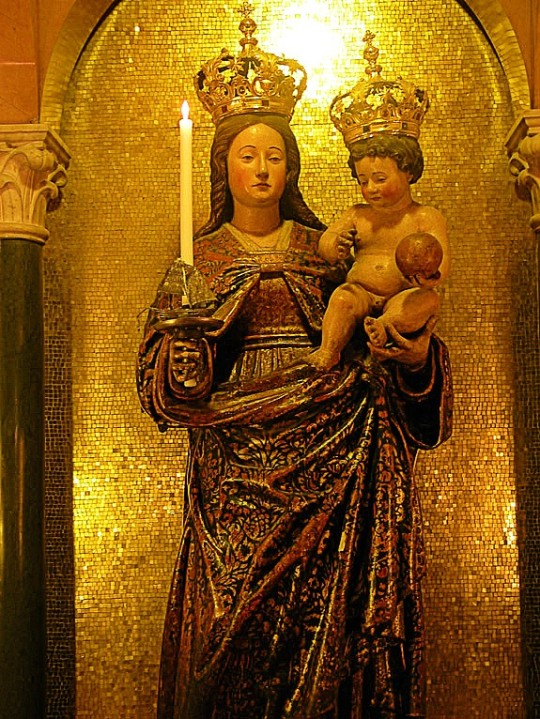
View On WordPress
#ourladyofbonaria#ourladyoflujan#saints24april#stegbert#stfidelisofsigmaringen#stmaryeuphrasiapelletier#stmellitusofcanterbury#stwilliamfirmatus
4 notes
·
View notes
Text
One Minute Reflection – 24 April – ' ... There is no doubt at all, that Saint Joseph was braver than David and wiser that Solomon ...'
One Minute Reflection – 24 April – The Octave Day of the Patronage of St Joseph – St Fidelis of Sigmaringen OFM Cap (1577-1622) Martyr – Genesis 49:22-26; Luke 3:21-23 – Scripture search here: https://www.drbo.org/
“And Jesus, Himself, was beginning about the age of thirty years, being – (as it was supposed) – the son of Joseph … ” – Luke 3:23
REFLECTION – “How faithful in humility was the…

View On WordPress
1 note
·
View note
Text
Our Lady of Bonaria, Island of Sardinia (1370) , Our Lady of Luján in Buenos Aires and Memorials of the Saints - 24 April
Our Lady of Bonaria, Island of Sardinia (1370) , Our Lady of Luján in Buenos Aires and Memorials of the Saints – 24 April
Saturday of the Third Week of Easter +2021
Nostra Signora di Bonaria / Our Lady of Bonaria, Island of Sardinia (1370) – 24 April:
The shrine of Our Lady of Bonaria (Good Air) dates back to the latter years of the fourteenth century, at Cagliari, on the island of Sardinia.According to tradition, on 25 March 1370, a ship ran into a terrific storm at a spot some miles off the coast of Sardinia…
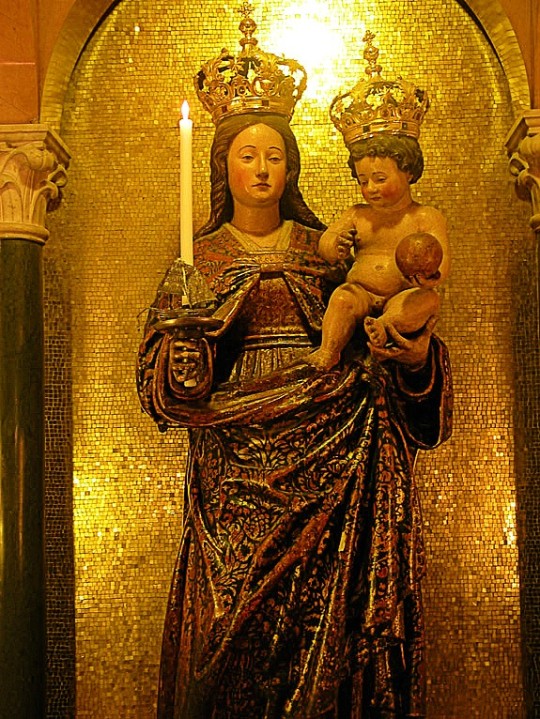
View On WordPress
#ourladyofbonaria#ourladyofLuján#saints24april#stbenedictmenni#stfidelisofsigmaringen#stmaryeuphrasiapelletier#stmarysalome#stmellitusofcanterbury#thepapalgolderose
4 notes
·
View notes
Text
Quote/s of the Day - 24 April - Faith and love ...
Quote/s of the Day – 24 April – Faith and love …

Quote/s of the Day – 24 April – Friday of the Second week of Easter and the Memorial of St Fidelis of Sigmaringen OFM.Cap (1577-1622) and St Mary Euphrasia Pelletier (1796-1868)
“O Catholic faith, how solid, how strong you are!
How deeply rooted, how firmly founded on a solid rock!
Heaven and earth will pass away but you can never pass away.
From the beginning the world opposed you
but you…
View On WordPress
8 notes
·
View notes
Text
Quote/s of the Day - 24 April - St Fidelis & St Mary Euphrasia Pelletier
Quote/s of the Day – 24 April – St Fidelis & St Mary Euphrasia Pelletier
Quote/s of the Day – 24 April – Wednesday of Easter week and the Memorial of St Fidelis of Sigmaringen OFM.Cap. (1577-1622) and St Mary Euphrasia Pelletier (1796-1868)
“Woe to me if I should prove myself
but a half-hearted soldier in the service
of my thorn-crowned Captain.”

“What made the holy apostles and martyrs
endure fierce agony and bitter torments,
except faith and especially faith in the…
View On WordPress
10 notes
·
View notes
Video
St Fidelis of Sigmaringen (1577-1622) Known as “The Poor Man’s Lawyer”
(via Feast of Our Lady of Bonnaria, Our Lady of Luján and Memorials of the Saints - 24 April)
4 notes
·
View notes
Text
24 April - Feast of Our Lady of Bonaria & Our Lady of Luján in Buenos Aires and Memorials of the Saints
24 April – Feast of Our Lady of Bonaria & Our Lady of Luján in Buenos Aires and Memorials of the Saints
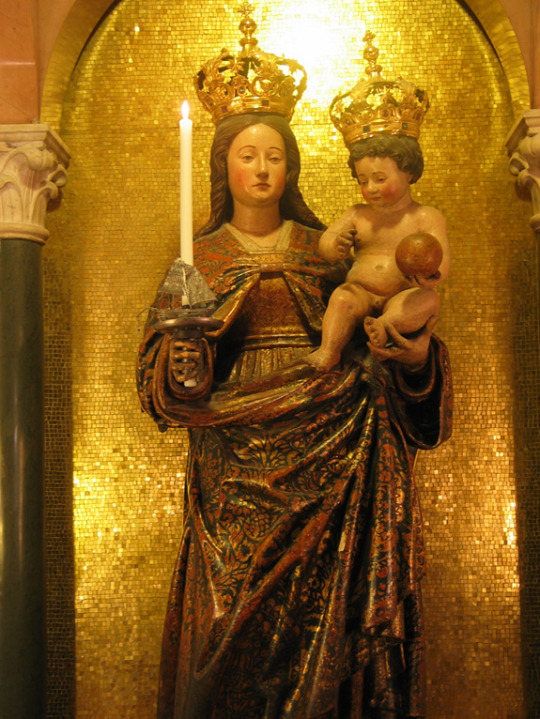
St Fidelis of Sigmaringen (1577-1622) Known as “The Poor Man’s Lawyer” (Optional Memorial)
Biography: https://anastpaul.wordpress.com/2017/04/24/saint-of-the-day-24-april-st-fidelis-of-sigmaringen/
Our Lady of Bonaria: Devotion to the Blessed Virgin Mary in the form of a statue of Mary and the Christ Child that was washed up at…
View On WordPress
#ourladyofbonnaria#ourladyofLuján#saints24april#stbenedictmenni#stfidelisofsigmaringen#stmaryeuphrasiapelletier
0 notes
Photo

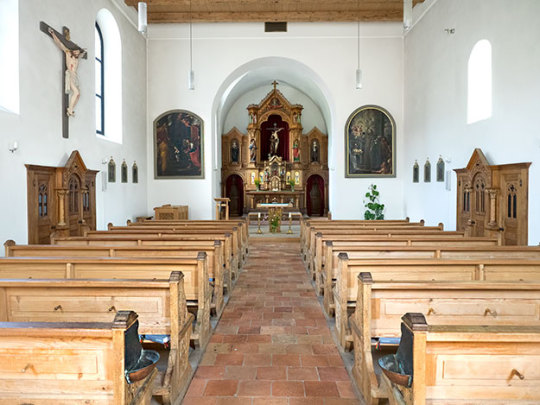
24 April – Blessed Memorial of St Fidelis of Sigmaringen O.F.M.Cap. (1577-1622) Religious Priest and MARTYR, lawyer/advocate, philosopher, teacher, apostle of Eucharistic Adoration and charity – Attributes – sword; palm of martyrdom; heretics; the Morning Star; trampling on the word “heresy”; with a club set with spikes; with a whirlbat; with an angel carrying a palm of martyrdom; with Saint Joseph of Leonessa. Major Shrine at the Capuchin friary of Weltkirchen (Feldkirch), Austria
St Fidelis was born Mark Roy or Rey in 1577 in Sigmaringen, a town in modern-day Germany, then under the Principality of Hohenzollern-Sigmaringen. His father’s name was John Rey. He studied law and philosophy at the University of Freiburg. Roy subsequently taught philosophy at this university, ultimately earning the degree of Doctor of Law. During his time as a student he did not drink wine and wore a hair-shirt. He was known for his modesty, meekness and chastity.
In 1604, Roy accompanied, as preceptor (teacher-mentor), three young Swabian gentlemen on their travels through the principal parts of Europe. During six years of travel, he attended Mass very frequently. In every town they came to, he visited the hospitals and churches, passed several hours on his knees in the presence of the Blessed Sacrament and was generous to the poor, sometimes giving them the very clothes off his back.
Upon his return, he practiced law as a counselor or advocate, at Colmar, in Alsace where he came to be known as the ‘poor man’s lawyer’. He scrupulously forbore all invectives, detractions and whatever might affect the reputation of any adversary. Disenchanted with the evils associated with his profession, he was determined to enter the religious life as a member of the Capuchin friars.
As soon as Fidelis finished his course of theology, he was immediately employed in preaching and in hearing confessions. After becoming guardian of the Capuchin friary in Weltkirchen, Feldkirch (in present-day Austria), many residents of the town and neighbouring places were reformed by his zealous labours and several Calvinists were converted. The Congregation of the Doctrine of the Faith commissioned Fidelis to preach in the Graubünden region of eastern Switzerland. Eight other Capuchin friars were to be his assistants and they laboured in this mission under his direction.

The Calvinists of that territory, being incensed at his success in converting their brethren, loudly threatened Fidelis’ life and he prepared himself for martyrdom. Fidelis and his companions entered into Prättigau, a small district of Graubünden, in 1622, on the Feast of the Epiphany, January 6. The effects of his ardent zeal, where the Bishop of Coire sent a lengthy and full account to the Congregation for the Propagation of the Faith, enraged the Calvinists in that province.
On April 24, 1622, Fidelis made his confession, celebrated Mass and then preached at Grüsch. At the end of his sermon, which he had delivered with more than ordinary zeal, he stood silent all of a sudden, with his eyes fixed upon Heaven, in ecstasy. He foretold his death to several persons in the clearest terms and began signing his letters, “P. Fidelis, prope diem esca vermium” (“Father Fidelis, in days ahead to become food for worms”). After the service at Grüsch he and several companions traveled to Seewis. His companions noted that he was particularly cheerful.
On April 24, in a campaign organised by the Habsburgs, Fidelis was preaching under protection of some Austrian imperial soldiers in the Church at Seewis with the aim to reconvert the people of Seewis to Catholicism. During the sermon, his listeners were called “to arms” by the Calvinist agitators outside. Some of the people went to face the Austrian troops outside the church. Fidelis had been persuaded by the remaining Catholics to immediately flee with the Austrian troops out of Seewis, which he did but then returned alone to Grüsch. On his way back he was confronted by 20 Calvinist soldiers who demanded unsuccessfully that he renounce the Catholic faith and when he refused, they subsequently murdered him.
A local account:
From Grüsch he went to preach at Seewis, where, with great energy, he exhorted the Catholics to constancy in the faith. After a Calvinist had discharged his musket at him in the Church, the Catholics entreated him to leave the place. He answered that death was his gain and his joy, and that he was ready to lay down his life in God’s cause. On his road back to Grüsch, he met twenty Calvinist soldiers with a minister at their head. They called him a false prophet and urged him to embrace their sect. He answered: “I am sent to you to confute, not to embrace your heresy. The Catholic religion is the faith of all ages, I fear not death.” One of them beat him down to the ground by a stroke on the head with his backsword. Fidelis rose again on his knees and stretching forth his arms in the form of a cross, said with a feeble voice “Pardon my enemies, O Lord: blinded by passion they know not what they do. Lord Jesus, have mercy on me. Mary, Mother of God, succour me!.” Another sword stroke clove his skull and he fell to the ground and lay in a pool of his own blood. The soldiers, not content with this, added many stab wounds to his body with their long knives and hacked-off his left leg, as they said, to punish him for his many journeys into those parts to preach to them.It is said that a Catholic woman lay concealed near the place of Fidelis’ martyrdom as the saint was slain. After the soldiers had left, she came out to assess the incident and found the martyr’s eyes open, fixed on the heavens. He was buried by Catholics the next day.
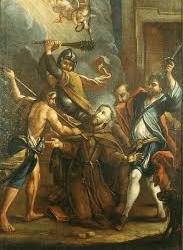
The rebels were soon after defeated by the imperial troops, an event which the martyr had foretold them. The Protestant minister who had participated in Fidelis’ martyrdom, was converted by this circumstance, made a public abjuration of Calvinism and was received into the Catholic Church.
After six months, the martyr’s body was found to be incorrupt but his head and left arm were separated from his body. The body parts were then placed into two reliquaries, one sent to the Cathedral of Coire, at the behest of the bishop and laid under the High Altar; the other was placed in the Capuchin church at Weltkirchen, Feldkirch, Austria.
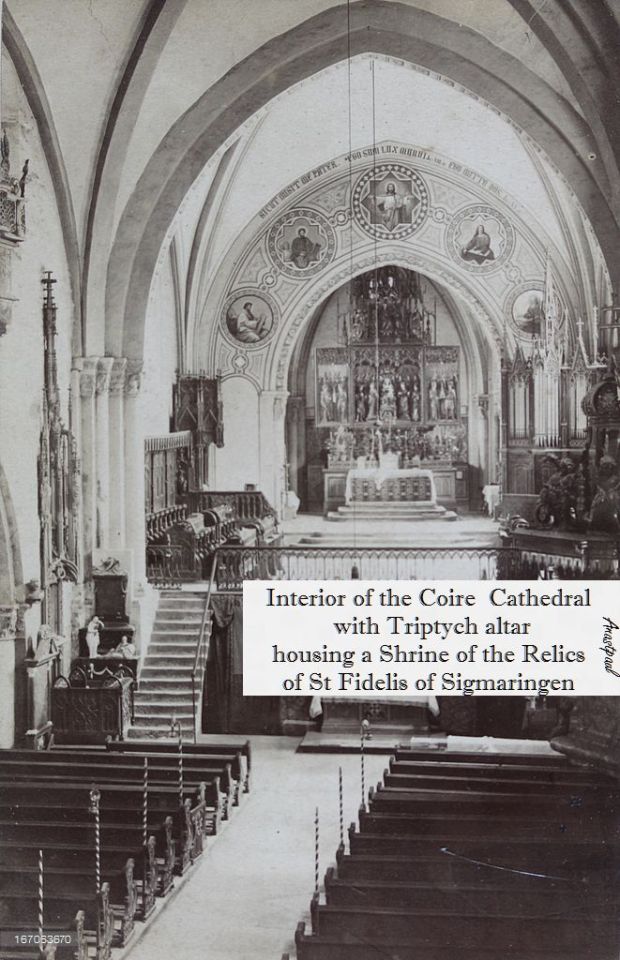
St Fidelis was beatified on 24 March 1729 by Pope Benedict XIII and canonised on 29 June 1746, Rome by Pope Benedict XIV
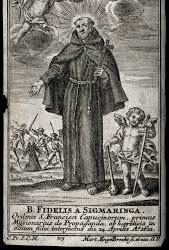

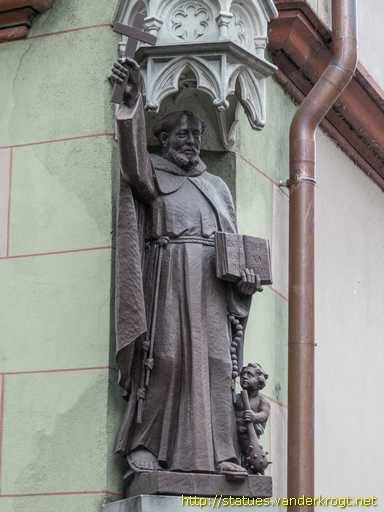

32 notes
·
View notes